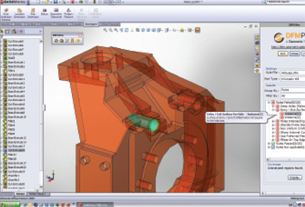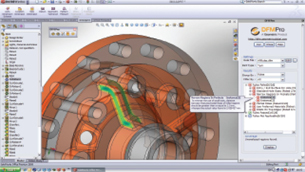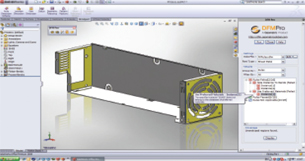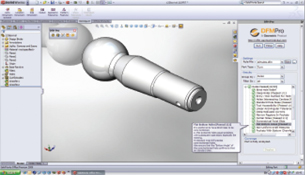DFMPro Offers a Streamlined Process
Knowledge-capture tools from Geometric enable SolidWorks designers to perform complete design checks and analysis in one session.
Latest News
April 1, 2008
By Al Dean
 In this inspection of a milled part using DFMPro, a hole has been detected whose end conditions arenot square or perpendicular to the hole’s axis. |
Stop to consider for a moment the wealth of simulation tools available to the designer and engineer. There’s one area that gets overlooked, and it’s one of the most critical when it comes to product realization: manufacturability. During these times of ultra-compressed development cycles, this is a little odd, don’t you think?
To answer this strange situation, a system called DFM (design for manufacturability) has been developed by Geometric (formerly GSSL). The intention is to provide a series of automated checks that assist in ensuring that your parts can be manufactured by milling, turning (including the increasingly popular mill/turn), and as folded sheet metal forms.
Of the three levels of product currently available, the first is the free utility integrated into SolidWorks 2008 called DFM Xpress. The next is the first “pay for” version, DFMPro, which provides the first real level of usable and complete functionality. And the final option is DFM Enterprise, which integrates the DFMPro tools into a fully customizable environment. Let’s begin with the free utility.
DFMXpress
As with all SolidWorks Xpress utilities, DFMXpress is free for everyone and is an appetizer for the more advanced products. It allows you to perform basic checks tailored to basic three-axis milling or turning. Start with a part, load up the add-in, and define the part type.
For prismatic (milled) parts, the basic checks are feature accessibility, fillets on outer edges, and hole-cavity intersections. There are also checks that can be tailored toward your machining capabilities and standard processes, such as hole depth to diameter ratio, pocket depth, flat bottomed holes; whether the holes conform to standard drill sizes, and the like. There are also a number of adaptable tolerance checks for minimum angular and linear tolerance zones. These same checks are used for turned parts, but these have task-specific checks such as corner radii and percentage bore relief.
One important thing to note is that the DFM tools work just as well with imported or third-party geometry. The system doesn’t use the SolidWorks feature geometry; instead it uses Geometric’s own feature recognition technology (as found in FeatureWorks). This means that you can maintain the same intellectual property (in terms of checks) across all of your data, irrespective of your geometry source. In other words, it works on imported data, too. You hit Run and the system presents you with the results, dividing them between those checks that passed and those that failed.
Each check can be expanded and you can see exactly where and why the problem occurred, with text feedback and a highlight on the model.
DFMPro
DFMPro builds on the same set of rules, checks, and other validation analyses in the Xpress version, but raises the bar on several fronts.
First, DFMPro has more checks, covering not only milled and turned parts, but also sheet metal. Second, customization and standardization is key, adding the ability to fully customize each rule and enabling you to have multiple databases (more on this later). Alongside adapting parameters to tailor each check to your requirements, you can also assign an importance value. This allows you to clearly see where critical problems lie, work on those, then move on to the rest.
The workflow is much the same: load the part, load the set of checks you want to use, and have the system chunk through feature recognition and inspection. Once complete, the results show you the rules that have failed (flagged in red), checks that have passed, and those that aren’t applicable. You can further organize those that have failed by filtering the results by importance, so critical problems can be dealt with immediately.
Again, feedback is linked, so selecting the check in the list will highlight the appropriate geometry and give you the details of the failure. While this interactive result-inspection process is useful, what you really need to be able to do is formalize those results into an automatically generated report; this is in XML format and provides full details of each failure and can include images. This, if you’re working in a managed environment, can be attached to a revision of a part and passed around with ECO workflows to ensure that everyone involved can gain an understanding of both why the part failed the checks and what needs to be done to fix the problem.
 This check on a mill/turn part has discovered a narrow region that might require the use of small toolsoutside of the companies’ standard cutter library. |
The Sheet Metal checks differ slightly as they address a radically different manufacturing process. To start a sheet metal part inspection, you need to define the database of rules as normal, but also a datum face from which the part is unfolded. As I said, the checks are sheet metal specific, so look at factors such as hole distance to bends. They also check material libraries and bend radii to ensure that the part you’re manufacturing can be built using standard in-stock materials.
Extending DFM
On top of the Professional version, several other options are available in this second version. First is a batch-process module, which allows you to run checks on a list of parts overnight or during downtime, providing tools that analyze and report on all of the problems encountered. There is also a Toolkit that enables you to create your own rules, should you have specific checks you need to perform on commonly encountered problems.
Over and above this, the DFM Enterprise version is essentially reserved for those seeking to fully customize the environment to their needs and integrate it into their data management environment (something I’d like to see become an option, rather than a consulting project).
Justifying the Ridiculously Easy
If you buy over the web, DFMPro costs $1500 for the professional version on a node-locked license, with a floating license rising to $4500 — a reasonable hike considering that this is not a tool to be used day in and day out by everyone. Costs for batch processing and the customization toolkits are in addition to that. The technology is ridiculously easy to use. The trick, however, might be in justifying the purchase.
There are lots of ways to do this, many of which relate to how you manufacture parts. If you’re an in-house manufacturer, the first thing to consider is the delay caused within your organization because manufacturing must pass parts back to design for rework because simple, commonsense rules haven’t been followed. While every designer or engineer should have a solid understanding of design for manufacture, things can get missed — and that introduces delays and rework.
For those involved in outsourcing manufacturing, DFMPro offers different options. For those contracting to a supplier, it means that you can use the same tools to maintain part design quality. If you’re working with suppliers, you can ensure (by having supplier-specific check databases) that the part they’re manufacturing can be optimized for their processes and skills. Again, if you’re outsourcing design, it also means that you can check the parts you receive from your design partners for manufacturability before they start the production process.
 This check has cross-referenced the part’s material against a library of standard materials kept in stock. |
Interestingly, if you’re a supplier or contract manufacturer, you can use a tool like this to provide feedback to clients and customers about the quality of their data in respect to your capabilities. This can result in saving time when feeding back design changes, but also makes your processes more efficient and adds value to your service offering.
Finding Flaws Saves Time
Whatever environment you work in, there are several key things to consider when looking at this tool. How much time do you devote to design for manufacture-related rework? Can you save that time by using an automated tool to find the hotspots? How much time is spent on design changes and revisions post manufacture? If you can find problems up front, before you begin production and tooling, then how much time can you save or devote to other processes (such as design optimization)? Finally, can you save manufacturing costs and time by removing difficult conditions within your parts? The system is ideal for finding non-obvious design flaws that could add cost and time to a manufacturing job.
 Flat-bottomed holes have been found in this part,whereas it’s conventional to use a standard drill andthat might cause problems in subsequent operations. |
We’re all used to optimizing product design for function and aesthetics, but if you can apply the same principles to manufacturing, then you can trim part-production costs and that always means a competitive advantage.
There’s the ability to formalize your manufacturing knowledge into a series of checks that can be deployed to your design team to try and squeeze out those simple errors that often throw the proverbial spanner into the production process. Finally, compare the cost of adopting DFM with the potential cost of correcting a design error once when just one of them makes it into manufacturing.
DFMPro is about streamlining processes with knowledge capture, reuse, and deployment in a non-intrusive manner, something particularly critical when you consider remote manufacturing. If you have the ability to ensure that components can be manufactured, then you’re going to remove a lot of problems, time, and cost associated with process improvement — which is certainly worth something that’s both easily quantifiable and worthy of investment.
More Info:
Geometric
Mumbai, India
dfmpro.geometricglobal.com
Contributing Editor Al Dean is the former technology editor at MCAD Magazine, a UK product development and manufacturing technology journal (mcadonline.com) and is editor of Prototype magazine (prototypemagazine.com). You can send comments about this article to [email protected].
Subscribe to our FREE magazine, FREE email newsletters or both!
Latest News
About the Author
DE’s editors contribute news and new product announcements to Digital Engineering.
Press releases may be sent to them via [email protected].






